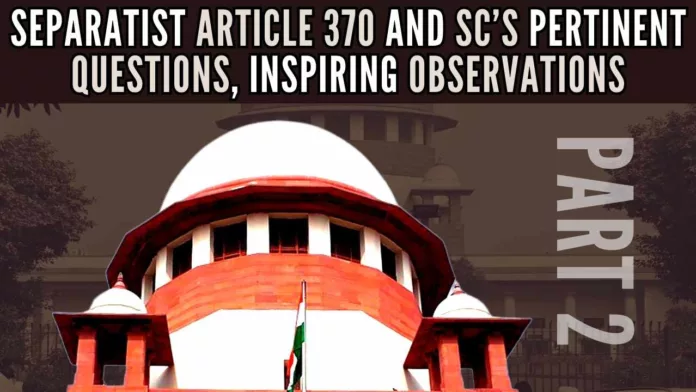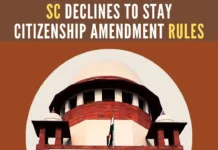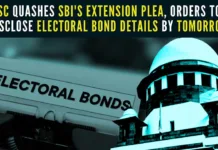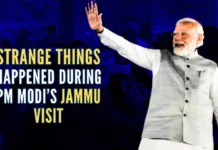
The previous 1 part of the article can be accessed here Part 1. This is the second part
SC hearing on Article 370 abrogation
A five-judge constitutional bench headed by Chief Justice of India, D Y Chandrachud, again on August 16 and 17 heard the petitions challenging the constitutional validity of the reorganization of the erstwhile J&K State and constitutional reforms as introduced by the Narendra Modi government on August 5-6, 2019. In the process, the petitioners’ lawyers advanced arguments against the otherwise path-breaking changes which were almost similar to the ones advanced earlier on August 2, 3, 8, 9, and 10, 2023 by other petitioners’ lawyers, including Kapil Sibal, Gopal Subramanium and Zafar Shah, and the apex court against put very significant questions and made meaningful queries and observations.
Rajeev Dhavan’s arguments
Advancing arguments against reorganization, Dhavan, who appeared for the separatist J&K People’s Conference, inter-alia, said: “Parliament can pass a law, subject to all limitations described in Articles 3 and 4 of the Constitution. Article 3 says Parliament can by law form a new state by separation of territory from any state or by uniting two or more states or parts of states or by uniting any territory to a part of any state. It can increase the area of any state, diminish the area of any state, alter the boundaries of any state, or alter the name of any state:
- ‘Provided that no Bill for the purpose shall be introduced in either House of Parliament except on the recommendation of the President and unless, where the proposal contained in the Bill affects the area, boundaries or name of any of the states, the Bill has been referred by the President to the legislature of that state for expressing its views thereon within such period as may be specified in the reference or within such further period as the President may allow and the period so specified or allowed has expired.’ Article 4 allows for consequential changes in the Ist Schedule i.e. names of the states in the Union of India and IVth Schedule i.e. the number of seats allotted in the Rajya Sabha for each state…There is a mandatory condition under Articles 3 and 4 of the constitution dealing with the formation of new states and alteration of areas, boundaries, or names of existing states where the president has to refer the matter to the state legislature…Reorganization of the state could not have been done when the state was under the proclamation of Article 356 (imposition of President’s Rule)…Parliament could not have substituted itself for the state legislature or the president for the Governor. The notification pertaining to J&K’s Reorganisation of 2019 created a constitutional amendment in Article 3 by suspending the mandatory provision of Article 3 (a reference by the President to the state legislature). It is a constitutional amendment that is subversive of the Constitution itself. If this suspension of mandatory provision fails in the eyes of the law, the President’s Rule will fail and its extension in July 2019 also fails…The Centre virtually amended the constitution and the entire J&K Reorganisation Act emanates from Articles 3 and 4 of the constitution…The President can suspend a provision of the Constitution but it has to supplement the proclamation. Here, in this case, this goes beyond supplementing, and a mandatory provision under Article 3 is actually taken out…I have never seen a provision that actually takes away a mandatory provision. This is exceptional. If you expand the ambit of Article 356(1)(c), then you will say that the President has a card to amend any part of the Constitution. Article 356(1)(c) has to be read with a mandatory provision which it cannot dilute…The words ‘necessary’ or ‘desirable’ are not carte blanche powers of the President. Could he have suspended Part III of the Constitution (that relates to fundamental rights) under Article 356 of the Constitution? It has to be given a limited meaning…Article 356 is an exception that overrides federalism and it brings down democracy in a state…During the President’s Rule, Articles 3 and 4 and Article 370 cannot be invoked. Why? Because they have conditionalities. The conditionality is specific to the legislature of the state…Neither Parliament nor President can substitute the legislature or the governor…President’s Rule cannot override Article 370 or Articles 3 and 4 or substitute the executive and legislature of the Union for the executive and legislature of J&K.
Articles 3 and 4 of the Indian Constitution have special applications to J&K and require the consent of the J&K legislature. President’s Rule’s provisions cannot obviate the provisions of Articles 3 and 4 as also those of Article 370(1) as the requirements of consent, consultation, and concurrence therein are mandatory…”[1]. - As regards abrogation of Article 370 or J&K’s internal autonomy, bordering on virtual sovereignty, Dhavan’s arguments read like this: “The Maharaja (Hari Singh) didn’t sign a standstill agreement…Article 370 was a substitute for the standstill or merger agreement without which we are lost…When Maharashtra was broken, they (SC) said you have to refer, whether you like it or not… You can’t self-refer it to Parliament…There is some misunderstanding on the status of the merger agreement. The court (in this case Chief Justice Chandrachud) had observed that after the Instrument of Accession, the surrender of sovereignty was absolute. Our submission is that as far as the Instrument of Accession is concerned, it deals with external sovereignty. That is lost with a few exceptions here and there. But internal sovereignty is not lost…The autonomy of states is fundamental to our Constitution…The democratization of power was necessary and without the existence of – a) autonomy given to states and; b) special provisions and concessions given to people when needed, India would collapse. Our Constitution doesn’t shy away from creating autonomous states…Autonomy is not alien to our constitution. To say that special provisions can’t be made in the Constitution is an anathema…The Indian Constitution was one of the most diverse constitutions in the world… India was not just an asymmetric federation but in fact, was a multi-symmetric federation…Article 3 could not have been invoked while the President’s Rule was going on…There were certain ‘conditionalities’ necessary for the exercise of Article 356…In this case, even the Governor’s report wasn’t placed before the Parliament. A full, frank, and complete disclosure to the Parliament and the people was necessary. The entire exercise of the President’s rule needs to be examined… India was not just an asymmetric federation but in fact, was a multi-symmetric federation…The abrogation of Article 370 went beyond supplementing the president’s rule and resulted in the removal of mandatory provisions…J&K is not a dead horse. The autonomy of a state cannot be wished away like this just because the government says ‘Okay the provision was taken away’…The autonomy of a state is fundamental to the Indian Constitution…There are certain states in North-East that enjoy autonomy (under Article 371)…The Constitution cannot be read like a statute and that Article 370 is part of the basic structure of the Constitution…” [2][3][4].
CJ Chandrachud’s questions to Dhavan, his observations
Unsatisfied CJ Chandrachud asked questions to Dhavan and made several observations. These, among others, read like this: “How do we deal with Article 356(1)(C)? So the President has the power to suspend certain provisions of the constitution during the operation of proclamation under 356…The President under President’s rule has the power to ‘make such incidental and consequential provisions as appear to the president to be necessary or desirable for giving effect to the objects of the proclamation…Normally when the legislature uses the word ‘means’ and ‘includes’ – it’s an indication of expanding the power so when the Constitution says ‘make incidental and supplementary provisions’ and then says ‘Including’ – this seems to widen the ambit of the earlier part’. ‘Including’ would mean that what was otherwise not a supplementary or incidental provision, it’s within the ambit of the presidential proclamation. Isn’t it?… The proviso seems to indicate that if the constitution wanted to exclude a power from the authority to suspend a provision of the Constitution, that has been specifically defined. The provision says that you will not suspend anything pertaining to an HC, or you will not assume to yourself the power of HC during the operation of Article 356. So where it wanted to restraint, it did so…Article 356 (1)(c) of the Constitution says in case of failure of the constitutional machinery in the state, the president on receipt of the report from the governor of the state, may issue a proclamation to make such incidental and consequential provisions which according to him is necessary or desirable for giving effect to the objects of the Proclamation, including provisions for suspending in whole or in part, the operation of any provisions of the Constitution relating to anybody or authority in the State…Whether Parliament can pass a law when there is President’s rule under Article 356, by resorting to Article 256 of the Constitution…Whether accepting the argument would amount to reading into Article 256, words that are not there. The proviso seems to indicate that if the constitution wanted to exclude a particular power from the authority to suspend a provision of the constitution, then that has been specifically defined…The proviso says that you will not suspend anything pertaining to a High Court, or you’ll not assume to yourself as President any of the powers of the High Court during the operation of 356. So where it wanted restraint on the Presidential power, it did so in the form of the proviso…Could we now say now that apart from the proviso, there may be certain other parts of the Constitution which the President cannot suspend, or would that be reading into Article 356 words are not there?”[5].
Justice Khanna’s observations on Dhavan’s argument
“Such a broad proposition (of Dhavan) with respect to the two Articles (356 and 256) may not be acceptable, as there may be situations that could not have been accounted for…There is a difference between the existence of power and the abuse of power, thus, let us not confuse it…”[6].
Dushyant Dave’s arguments
The arguments given by Dushayant Dave appearing for the petitioners read: “Article 370(3), which was a temporary provision in terms of its object to start with, had subsequently acquired a permanent character…The constitutional orders post-1957 were only for the purpose of clause I of Article 370 to extend many amendments from time to time, ‘because there were many provisions of the constitution which could not have been made applicable or many laws which may not have been applicable…Article 370(3) is only in respect of the continuation of 370 or not. Once the constituent assembly agrees that it should be continued, it becomes some sort of a permanent decision… They (Government of India) have applied all provisions of the Constitution by 1954. So really speaking, there is nothing left to be done… 370 is fully in operation now…‘A wrong practice’ cannot lead to the rewriting of the provision. (Dave was apparently referring to the amendments being carried out by way of Constitutional orders.)…Article 370 is perhaps the most brilliant articulation of statesmanship on the part of the framers of the Constitution. You are at a time when calls for the plebiscite are being raised in Kashmir. You are at a time when raiders are raiding in plain clothes…You are at a time when Maharaja is uncertain whether he wants to join India or Pakistan. At a time like that, this was a brilliant compromise that was arrived at, which led to producing the Article which persuaded people of J&K to accede to India…”[7].
Chandrachud’s questions to Dave, his observations
“The argument that Article 370 had become permanent after the Constituent Assembly for J&K ceased to exist in 1957 is belied by the practice of issuing Constitution (Application) Orders from time to time, modifying the Constitution in relation to the erstwhile state…The ‘judicial review’ of the Centre’s action ‘will be confined to a constitutional violation’ and cannot be about the wisdom of the decision. ‘If Article 370 works itself out and achieves its purpose once the constituent assembly for the State of J&K has completed its task, then where was the occasion thereafter to issue constitutional orders post-1957…‘We are talking of practice of 64 years’…Proviso (d) of clause 1 which says that matters that are referable to the Instrument of Accession require only consultation with the state government while all other provisions require concurrence…Clause 2 of Article 370 says that if the concurrence is given before the constituent assembly has given its opinion, then it has to be placed before the constituent assembly for its opinion and concurrence. ‘Your (Dave’s) whole argument is Article 370 has worked itself out once the constituent assembly completes its task. But that would be belied at the least by constitutional practice because even after 1957 there were orders which were issued…Therefore, it would not be correct to postulate that Article 370 achieved its life (and) what is a temporary provision really assumes a state of permanence in the Indian Constitutional fabric…But then where is the power to alter the constitution at all? If your argument is right, then once the constituent assembly in 1957 takes a decision, there is no power to change any provision of the constitution in relation to the state of J&K…There is one internal inconsistency in accepting Dave’s submission. ‘Because if it is right, quay the proviso to clause 3, then the consequence would be that once the constituent assembly completed its task in 1957, there could be no amendment to the constitution at all under 370(2), which is belied not merely by constitutional practice but the acceptance by both the State of J&K and Government of India that amendments were being made by the constitution even after 1957 and until the disputed amendment of 2019…But then would the power of the state government to grant its concurrence under the second proviso to clause (d) continue to operate once the constituent assembly completed its task in 1957? Or would that power be exhausted…You (Dave) are right logically. But then how do you explain that there were subsequent amendments to the constitution by the Constitution Orders…”[7][8].
Shekhar Naphade’s arguments
Shekhar Naphade, who also appeared for the petitioners, argued like this: “Existence of J&K Constitution is recognized by the Constitution of India. The legislative assembly was dissolved in Nov 2018 and the Governor assumes the power under the J&K Constitution and the 356 since the Governor had already dissolved the assembly and assumed all powers of the state and this assuming of power will not mean the breakdown of law and order machinery. This is a jurisdictional issue and Article 356 has been invoked for a collateral purpose and the collateral purpose is apparent in the face of the record. The J&K Reorganization Act is born unconstitutionally…The existence of states is a part of the basic structure and J&K cannot be an exception to this. What is the impact on constitutional structure? Where everything has been turned upside down. Ladakh has no representation in the Rajya Sabha. So much for democracy. Ladakh has nothing to do with the working of the Rajya Sabha. Now Lok sabha…under Article 81(b), all UTs can have maximum 20 seats. Now J&K has no proportionate representation in Lok Sabha. It is discrimination and attracts Article 14 violation”[9].
The arguments advanced by Dhavan, Dave, and Naphade and questions put and observations, and queries made by Chief Justice Chandrachud and Justice Khanna do suggest that the constitutional bench and votaries of Article 370 and critics of J&K’s reorganization are not really on the same page. In other words, some of the contradictions between the two appear to be non-reconcilable. Let’s wait and see. The next date of the hearing is August 22.
To be continued…
Reference:
[1] Article 370: SC Asks If Parliament Can Enact Law To Divide J&K Into Two UTs During President’s Rule – Aug 17, 2023, State Times
[2] Can Parl enact law to divide J&K into 2 UTs during Prez rule, asks SC – Aug 17, 2023, Daily Excelsior
[3] Article 370 case: Rajeev Dhavan contests CJI’s observation that transfer of J&K’s sovereignty to India is complete – Aug 16, 2023, The Tribune
[4] J&K Maharaja did not surrender all sovereignty to India: Petitioners to SC – Aug 17, 2023, Indian Express
[5] Article 370 Case: Live Updates From Supreme Court [Day 6] – Aug 17, 2023, Live Law
[6] Supreme Court says Centre using legal power to abrogate Article 370 should not be confused with abuse of process – Aug 16, 2023, India Legal
[7] On argument of Article 370 ‘permanence’, Supreme Court asks: How were amendments made – Aug 18, 2023, Indian Express
[8] Article 370: SC questions issuance of constitutional orders for J-K post 1957 – Aug 18, 2023, National Herald
[9] Challenge to Article 370 abrogation can be only on constitutional violations, not government’s intention: Supreme Court – Aug 17, 2023, Bar and Bench
Note:
1. Text in Blue points to additional data on the topic.
2. The views expressed here are those of the author and do not necessarily represent or reflect the views of PGurus.
[With Inputs from IANS]
PGurus is now on Telegram. Click here to join our channel and stay updated with all the latest news and views
For all the latest updates, download PGurus App.











Do not know what is being achieved, with the long arguments full of researched vocabularies from all dictionaries of the world, only one great leader is missing who has better vocabulary than all of them put together. Can the clock be turned back? If the answer is no, then all the lawyers of Delhi are having a field day talking against the government and making tons of money. Would be interesting to know who is paying and how much to each one of them.